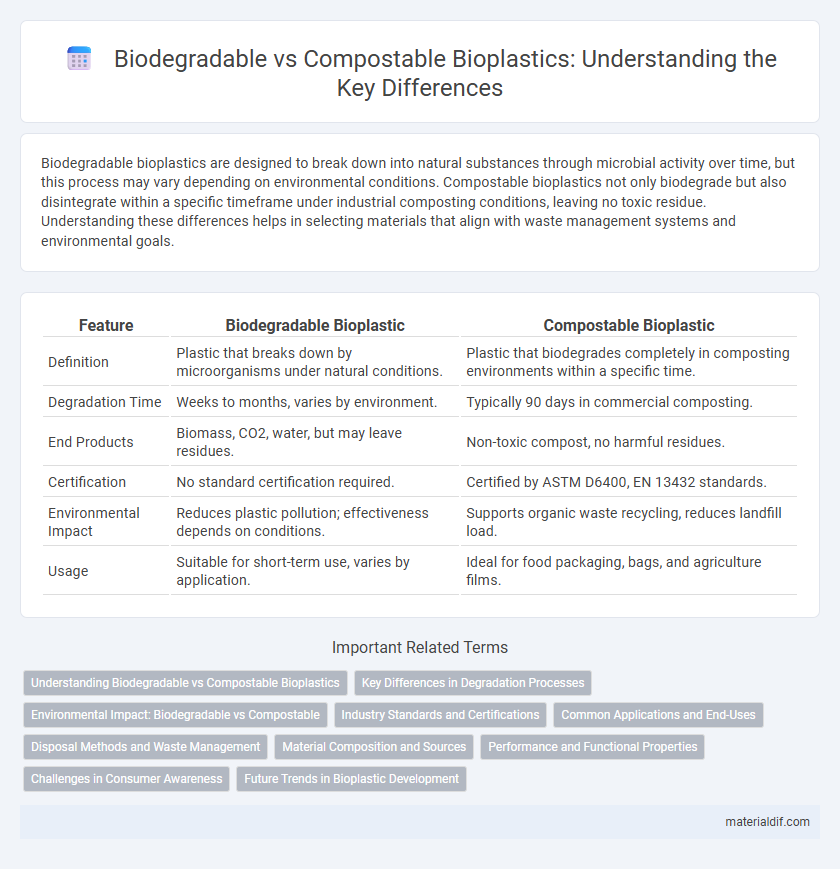Biodegradable bioplastics are designed to break down into natural substances through microbial activity over time, but this process may vary depending on environmental conditions. Compostable bioplastics not only biodegrade but also disintegrate within a specific timeframe under industrial composting conditions, leaving no toxic residue. Understanding these differences helps in selecting materials that align with waste management systems and environmental goals.
Table of Comparison
| Feature | Biodegradable Bioplastic | Compostable Bioplastic |
|---|---|---|
| Definition | Plastic that breaks down by microorganisms under natural conditions. | Plastic that biodegrades completely in composting environments within a specific time. |
| Degradation Time | Weeks to months, varies by environment. | Typically 90 days in commercial composting. |
| End Products | Biomass, CO2, water, but may leave residues. | Non-toxic compost, no harmful residues. |
| Certification | No standard certification required. | Certified by ASTM D6400, EN 13432 standards. |
| Environmental Impact | Reduces plastic pollution; effectiveness depends on conditions. | Supports organic waste recycling, reduces landfill load. |
| Usage | Suitable for short-term use, varies by application. | Ideal for food packaging, bags, and agriculture films. |
Understanding Biodegradable vs Compostable Bioplastics
Biodegradable bioplastics break down through natural processes by microorganisms into water, carbon dioxide, and biomass over time, but their decomposition rate and conditions vary widely. Compostable bioplastics require specific industrial composting environments with controlled temperature, humidity, and microbial activity to efficiently decompose into non-toxic residues within a defined timeframe, typically 90 days. Understanding the distinction helps in selecting appropriate disposal methods, as compostable materials are designed for faster, cleaner degradation in compost facilities, whereas biodegradable plastics may persist longer in natural environments.
Key Differences in Degradation Processes
Biodegradable bioplastics break down through microbial activity into water, carbon dioxide, and biomass under various environmental conditions, but this process can be slow or incomplete depending on factors like temperature and oxygen availability. Compostable bioplastics degrade rapidly within industrial composting facilities where controlled conditions such as elevated temperature, humidity, and microbial diversity accelerate their breakdown into non-toxic organic matter within a specified timeframe, usually 90 to 180 days. The key difference lies in the guaranteed complete decomposition of compostable bioplastics under standardized composting parameters, whereas biodegradable bioplastics may not fully degrade outside ideal or specialized environments.
Environmental Impact: Biodegradable vs Compostable
Biodegradable bioplastics break down through natural processes but may leave microplastic residues, impacting soil and water ecosystems negatively. Compostable bioplastics decompose fully into non-toxic organic matter within a regulated timeframe under industrial composting conditions, enhancing soil health and reducing landfill waste. Choosing compostable bioplastics supports circular economy goals by minimizing environmental pollution and promoting sustainable waste management.
Industry Standards and Certifications
Biodegradable bioplastics are designed to break down under natural conditions but may require specific environments to degrade effectively, often certified by standards such as ASTM D6400 or EN 13432. Compostable bioplastics meet stricter criteria, decomposing within defined time frames in industrial composting facilities, with certifications like TUV AUSTRIA OK Compost or Seedling ensuring compliance with these industry standards. These certifications verify the material's ability to safely return to the environment without toxic residues, supporting sustainability goals in packaging and product manufacturing sectors.
Common Applications and End-Uses
Biodegradable bioplastics are commonly used in packaging, agricultural films, and disposable items where controlled environmental breakdown is essential, but specific composting conditions are not required. Compostable bioplastics find higher utilization in food service products, such as cutlery, plates, and bags, that are designed for industrial composting facilities to ensure complete degradation. Both types serve the sustainability sector but differ in end-use settings, with compostable bioplastics aligning closely with certified composting programs for organic waste management.
Disposal Methods and Waste Management
Biodegradable bioplastics break down through microbial activity under various natural conditions, but their decomposition rate and byproducts can vary widely, impacting waste management strategies. Compostable bioplastics require specific industrial composting environments with controlled temperature, humidity, and microbial activity to fully degrade into non-toxic residues, making them ideal for regulated disposal systems. Effective waste management involves correctly sorting these bioplastics to ensure they enter appropriate disposal streams, minimizing environmental contamination and optimizing resource recovery.
Material Composition and Sources
Biodegradable bioplastics are typically made from natural polymers like starch, cellulose, or polylactic acid (PLA), which can break down through microbial activity over time in various environments. Compostable bioplastics, often derived from similar renewable resources such as corn starch or sugarcane, are specifically engineered to decompose within industrial composting facilities under controlled temperature, moisture, and microbial conditions. The key distinction lies in compostable bioplastics requiring certified industrial composting processes, while biodegradable bioplastics may degrade in less stringent conditions but lack standardized decomposition timelines.
Performance and Functional Properties
Biodegradable bioplastics break down through microbial activity under various environmental conditions but may leave residues or require specific settings for complete degradation, impacting their performance in long-term applications. Compostable bioplastics are designed to disintegrate fully within industrial composting systems, ensuring no toxic residues and maintaining soil health, making them highly functional for circular waste management. The functional properties of compostable bioplastics often include enhanced compatibility with composting infrastructure, whereas biodegradable types may exhibit variable performance depending on environmental factors and material composition.
Challenges in Consumer Awareness
Biodegradable bioplastics often confuse consumers due to vague labeling and misconceptions about decomposition timelines, leading to improper disposal and environmental harm. Compostable bioplastics require specific industrial composting conditions, but lack of standardized consumer education results in these materials frequently ending up in landfills, where they do not break down effectively. Enhancing clear communication and standardized labeling is critical to overcoming these challenges and promoting correct disposal practices.
Future Trends in Bioplastic Development
Future trends in bioplastic development emphasize enhancing the performance of biodegradable bioplastics by improving their degradation rates in diverse environments. Advances in compostable bioplastic formulations target faster breakdown in industrial and home composting systems, aligning with circular economy goals. Innovations include incorporating bio-based additives and enzymes to optimize biodegradability while maintaining material strength and usability.
Biodegradable bioplastic vs Compostable bioplastic Infographic

 materialdif.com
materialdif.com